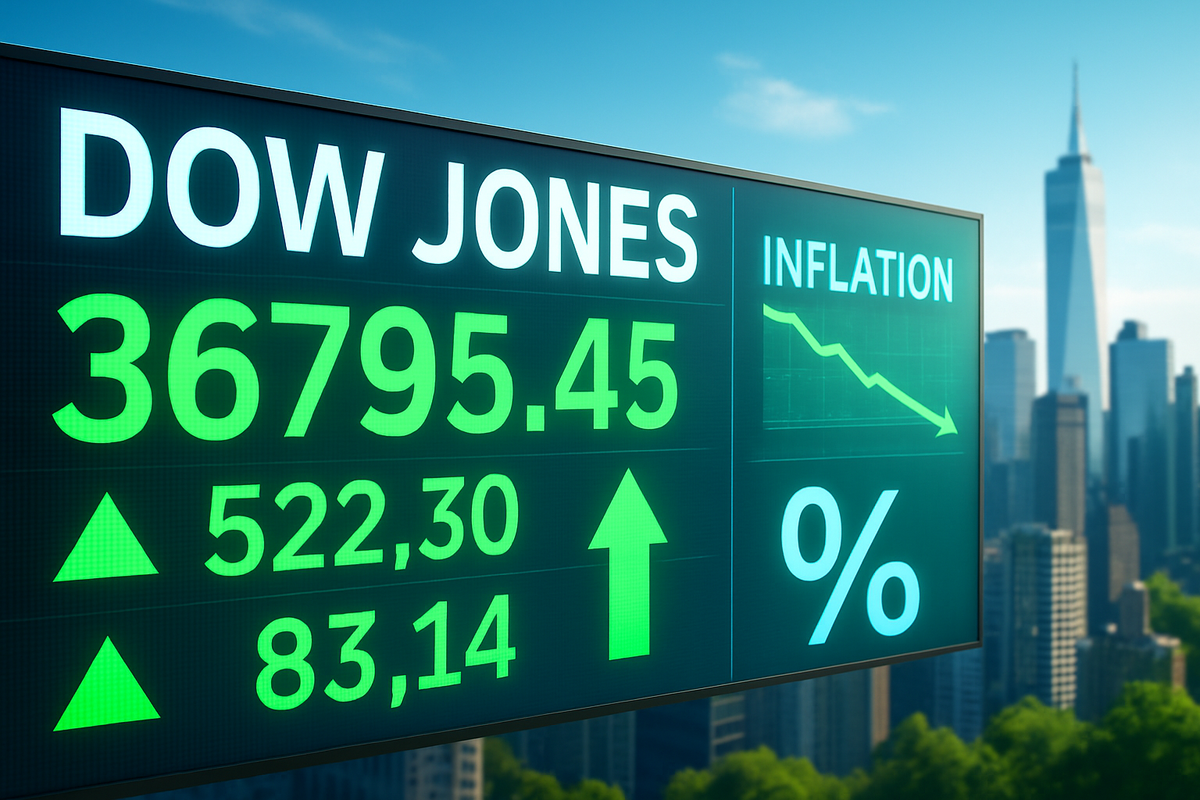
The Dow Jones Industrial Average (DJIA) has demonstrated remarkable strength, surging by 1.1% or 483.52 points to close at 44,458.61. This significant rally places the venerable blue-chip index within a mere 1.4% of its all-time high, which was recorded in December 2024 when it surpassed the 45,000-point mark. This robust performance is not an isolated event but rather a key contributor to a wave of overwhelmingly positive sentiment sweeping across the broader stock market, signaling a potential shift in the economic landscape.
This upward momentum reflects a collective sigh of relief among investors, who are increasingly optimistic about the trajectory of inflation and the future of monetary policy. The market's current exuberance is underpinned by a confluence of favorable economic indicators and strategic developments, setting a promising stage for continued growth and potentially higher corporate earnings in the near future.
What Happened and Why It Matters
The recent surge in the Dow Jones Industrial Average is a direct consequence of several pivotal developments that have reshaped market expectations. The index's gain of 483.52 points to 44,458.61 underscores a significant shift in investor confidence, bringing it tantalizingly close to its December 2024 peak. This rally is not merely a statistical anomaly but a reflection of deep-seated changes in the economic outlook.
A primary catalyst for this market optimism was the release of July's inflation data. The Consumer Price Index (CPI) showed a modest increase of 0.2% month-over-month and 2.7% year-over-year. Crucially, this figure came in slightly below the Dow Jones consensus estimate of a 2.8% annual increase, providing concrete evidence that inflationary pressures are indeed cooling faster than many had anticipated. This moderation in price increases alleviates a significant concern that has weighed on markets for months, paving the way for a more accommodative monetary policy.
Following the favorable inflation report and unexpectedly weak jobs data for July, market participants are now highly confident that the Federal Reserve will initiate its first interest rate cut as early as September. The probability of a 25-basis-point rate cut in September has surged to between 93.4% and 94.5% according to the CME FedWatch Tool. Lower interest rates are generally perceived as a significant boon for investment prices and the broader economy, as they reduce borrowing costs for businesses and consumers, stimulating investment and spending.
Furthermore, investor sentiment was bolstered by positive news on the trade front, including an extension of the "tariff truce" with China. This development reduces geopolitical uncertainty and fosters a more stable environment for international trade, which is crucial for global economic growth. The positive momentum was not confined to the Dow; the tech-heavy Nasdaq Composite (NASDAQ: COMP) rallied 1.4% to finish at 21,681.90, marking a new closing high, and the S&P 500 (NYSE: SPX) advanced 1.1% to close at 6,445.76, also achieving a new closing high. All 11 broad sectors of the S&P 500 ended in positive territory, with technology and communication services sectors showing particularly strong gains. Reflecting this increased investor optimism, the CBOE Volatility Index (VIX), often referred to as the market's "fear gauge," dropped significantly by 9.4% to 14.73, indicating decreased market volatility and heightened confidence.
Winners and Losers in a Shifting Landscape
The current market rally, fueled by easing inflation and the prospect of Federal Reserve rate cuts, is creating clear winners and losers across various sectors. Companies that are highly sensitive to interest rates and economic growth are poised to benefit significantly, while others may find themselves on the sidelines or facing headwinds.
Technology and communication services sectors have already demonstrated strong gains, with the Nasdaq Composite (NASDAQ: COMP) hitting a new closing high. Companies like Apple (NASDAQ: AAPL), Microsoft (NASDAQ: MSFT), and Alphabet (NASDAQ: GOOGL) (parent company of Google) are likely to see continued investor interest. Lower borrowing costs make it cheaper for these companies to fund innovation, expansion, and share buybacks, which can boost their stock prices. Furthermore, a more robust consumer spending environment, spurred by lower interest rates, directly benefits these sectors through increased demand for their products and services. Growth stocks, which often rely on future earnings potential, tend to perform well in a low-interest-rate environment as their future cash flows are discounted at a lower rate, making them more valuable today.
Conversely, sectors that thrive on higher interest rates, such as certain segments of the financial industry, might experience some pressure. While banks generally benefit from a steeper yield curve, a rapid decline in interest rates could compress net interest margins for some lenders. However, the overall positive economic sentiment and increased lending activity could offset some of these pressures. Companies with high debt loads that have struggled with rising interest payments will find relief, potentially improving their profitability and solvency. On the other hand, defensive sectors like utilities and consumer staples, which are often favored during periods of uncertainty and higher interest rates for their stable dividends, might see less relative outperformance as investors flock to growth-oriented assets.
The real estate sector, particularly Real Estate Investment Trusts (REITs), could also be a significant beneficiary. Lower interest rates reduce the cost of financing new projects and make existing properties more attractive to buyers, potentially leading to increased transaction volumes and property valuations. Companies like Simon Property Group (NYSE: SPG) or Prologis (NYSE: PLG) could see renewed interest. Overall, the market's shift towards a more accommodative monetary policy is broadly positive for equities, but the benefits will be unevenly distributed, favoring companies with strong growth prospects and those that can leverage cheaper capital.
Industry Impact and Broader Implications
The Dow's ascent and the broader market's positive momentum are not isolated events but rather integral parts of a larger narrative of economic recalibration. This event fits squarely into the broader industry trend of a potential "soft landing" for the economy, where inflation cools without triggering a severe recession. The market's reaction suggests that investors are increasingly confident in the Federal Reserve's ability to navigate this delicate balance, moving from an aggressive tightening cycle to a more neutral or even accommodative stance.
The potential ripple effects on competitors and partners are significant. For instance, in the technology sector, the renewed optimism could spur increased venture capital funding and M&A activity, as companies feel more confident in their growth prospects and access to capital. Smaller, innovative firms might find it easier to secure funding, while larger players could look to acquire promising startups. In the retail and consumer discretionary sectors, a more confident consumer, buoyed by stable prices and potentially lower borrowing costs, could lead to increased spending, benefiting companies like Amazon (NASDAQ: AMZN) or Walmart (NYSE: WMT).
From a regulatory and policy perspective, the easing inflation and strong market performance might reduce the immediate pressure on policymakers to intervene with further fiscal stimulus or restrictive measures. Instead, the focus might shift towards maintaining economic stability and fostering long-term growth. The Federal Reserve's data-dependent approach means that continued positive inflation and employment data will reinforce the path towards rate cuts, solidifying market expectations. Historically, periods of sustained market rallies following inflation moderation have often been precursors to extended periods of economic expansion, provided that no new significant shocks emerge. Comparisons can be drawn to post-recession recovery periods where monetary easing played a crucial role in stimulating growth, albeit with different inflationary backdrops.
What Comes Next
Looking ahead, the immediate future for the Dow Jones and the broader market appears cautiously optimistic, but several factors will dictate the trajectory. In the short term, market participants will be keenly watching upcoming inflation reports and Federal Reserve communications. Any deviation from the current narrative of cooling inflation or a less dovish stance from the Fed could introduce volatility. However, if the current trends persist, the Dow Jones is likely to test and potentially surpass its all-time high, drawing in more capital and reinforcing the positive feedback loop.
In the long term, the market's performance will hinge on the actual impact of the anticipated rate cuts on corporate earnings and economic growth. Cheaper borrowing costs should stimulate investment and consumption, but the extent of this impact will depend on underlying economic fundamentals and global demand. Companies will need to strategically pivot or adapt to this new environment. Those that can efficiently leverage lower capital costs for innovation, market expansion, or debt reduction will be best positioned for sustained growth. This could lead to increased capital expenditures across various industries, driving productivity gains.
Market opportunities may emerge in sectors that are particularly sensitive to interest rates, such as housing, automotive, and certain segments of manufacturing. Furthermore, a stable economic environment could encourage more initial public offerings (IPOs) and secondary offerings, providing new investment avenues. Challenges could arise from unforeseen geopolitical events, a resurgence of inflationary pressures, or a less robust global economic recovery than anticipated. Potential scenarios range from a continued "goldilocks" environment of moderate growth and low inflation to a more challenging landscape if economic data deteriorates or external shocks occur. Investors should remain vigilant, focusing on companies with strong balance sheets and adaptable business models.
Conclusion
The Dow Jones Industrial Average's impressive rally, bringing it within striking distance of its all-time high, marks a significant turning point in the current financial narrative. The key takeaway is a palpable shift in market sentiment, driven by compelling evidence of easing inflation and the strong likelihood of imminent interest rate cuts by the Federal Reserve. This confluence of factors has instilled a renewed sense of confidence among investors, leading to broad market gains and a notable decrease in volatility.
Moving forward, the market appears poised for continued positive momentum, provided that the economic data remains supportive of the "soft landing" scenario. The prospect of cheaper capital is a powerful stimulant for corporate investment and consumer spending, which could translate into higher corporate earnings and sustained equity appreciation. However, investors should remain discerning, recognizing that while the tide is rising, not all boats will lift equally. Companies in technology and communication services, along with interest-rate-sensitive sectors like real estate, are likely to be among the primary beneficiaries.
In the coming months, investors should closely monitor the Federal Reserve's actions and rhetoric, as well as subsequent inflation and employment reports. Any divergence from the current optimistic outlook could introduce headwinds. Furthermore, global economic developments and geopolitical stability will continue to play a crucial role. The current market environment presents both opportunities for growth and the need for strategic positioning, emphasizing the importance of a well-diversified portfolio and a keen eye on evolving economic indicators. The journey to new all-time highs for the Dow Jones is not just a numerical milestone but a testament to the market's adaptability and resilience in the face of evolving economic challenges.





